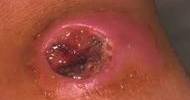A convergent process may explain how the two major genetic risk factors for autism spectrum disorder/intellectual impairment (ASD/ID) cause these neurodevelopmental abnormalities, according to researchers from the University at Buffalo.
Even though ASD and ID are separate conditions, a sizeable portion about 31% of those with ASD also displays ID. Both diseases are poorly understood at the molecular level.
“Given the vast number of genes known to be involved in ASD/ID and the many potential mechanisms contributing to the disorders, it is exciting to find a shared process between two different genes at the molecular level that could be underlying the behavioral changes,” said Megan Conrow-Graham, PhD, first author and an MD/PhD candidate in the Jacobs School of Medicine and Biomedical Sciences at UB.
The study, which was just published in the journal Brain, focuses on ADNP and POGZ, the top two risk genes for ASD/ID. According to the research, mutations in these genes cause immune response genes and genes for a kind of immune cell called microglia to be abnormally activated and over expressed.
“Our finding opens the possibility of targeting microglia and immune genes for treating ASD/ID, but much remains to be studied, given the heterogeneity and complexity of these brain disorders,” said Zhen Yan, PhD, senior author and SUNY Distinguished Professor in the Department of Physiology and Biophysics in the Jacobs School.
The UB researchers discovered that variations in the two genes under investigation activate microglia and result in overexpression of immune genes in the brain. The expected outcome is aberrant synaptic function, which is a hallmark of ASD/ID.
Both postmortem brain tissue from people with ASD/ID and experiments on mice in which ADNP and POGZ were silenced by viral delivery of short interfering RNA were used in the investigation. These mice performed cognitive tasks like spatial memory, object recognition memory, and long-term memory less well.
Weakening a repressive function
“Under normal conditions, cells in the central nervous system should not express large quantities of genes that activate the immune system,” said Conrow-Graham. “ADNP and POGZ both work to repress these genes so that inflammatory pathways are not continuously activated, which could damage surrounding cells. When that repression is weakened, these immune and inflammatory genes are then able to be expressed in large quantities.”
We found that changes in two risk genes lead to a convergent mechanism, likely involving immune activation. However, this probably isn’t the case for all individuals with ASD/ID. When designing clinical trials to evaluate treatment effectiveness, I think our research underscores the importance of considering the genetic factors involved in an individual’s ASD/ID.
Megan Conrow-Graham
The pro-inflammatory response was triggered by the elevated genes in the mouse prefrontal cortex as a result of ADNP or POGZ deficiency.
“This is consistent with what we see in upregulated genes in the prefrontal cortex of humans with ASD/ID,” said Conrow-Graham.
The prefrontal cortex is the region of the brain responsible for executive function, such as cognitive and emotional regulation. Microglia, which make up 10-15% of all brain cells and operate as support cells for neurons as well as having an immunological function in the brain, are also activated by the mutant genes.
Sensitive microglia
“Microglia are very sensitive to pathological changes in the central nervous system and are the main form of active immune defense to maintain brain health,” explained Yan. “Aberrant activation of microglia, which we demonstrate occurs as a result of a deficiency in ADNP or POGZ, could lead to the damage and loss of synapses and neurons.”
Future studies should be able to determine whether chronic neuroinflammation may be directly responsible for at least some cases of ASD/ID, in which case targeting microglia or inflammatory signaling pathways may be an effective treatment.
The clinical manifestations of both ASD and ID are remarkably variable, the researchers said. Significant diversity is also probably present in the types of mechanisms causing ASD and/or ID symptoms.
“We found that changes in two risk genes lead to a convergent mechanism, likely involving immune activation,” said Conrow-Graham. “However, this probably isn’t the case for all individuals with ASD/ID. When designing clinical trials to evaluate treatment effectiveness, I think our research underscores the importance of considering the genetic factors involved in an individual’s ASD/ID.”
Conrow-PhD Graham’s research has culminated, and she has returned to the Jacobs School to finish the remaining two years of her MD program. She said that her experiences going after both a PhD and an MD were quite complementary.
The immune system has a role
“My training at each level was super helpful to supplement the other,” she said. “When I began my PhD, I had completed two years of MD training, so I was familiar with the basics of physiology, anatomy, and pathology. Because of this, I was able to bring a broader perspective to my neuroscience research, identifying how the immune system might be playing a role. Prior to this, our lab had not really investigated immunology-related pathways, so having that background insight was really beneficial.”
She continued by saying that she had gained a great deal of knowledge from all of her lab mates in Yan’s lab, including professors, lab workers, and other students. “I learned so many technical skills that I had never used before joining the lab, thanks to the dedication of lab co-workers for my training,” she said.
Her work as a clinician will undoubtedly be influenced by her previous expertise focusing on the fundamental science underpinning neuropsychiatric illnesses in the lab.
“I plan to pursue a career as a child and adolescent psychiatrist, so I may be able to work directly with this patient population,” she said. “We’re learning now that better care may be able to be provided by taking a personalized medicine approach, taking into account genetics, psychosocial factors, and others. Being able to take a very deep dive into the field of psychiatric genetics was a privilege that I hope will help me to provide the best care for patients.”
The Nancy Lurie Marks Family Foundation and Conrow-Ruth Graham’s L. Kirschstein Individual Predoctoral NRSA for MD/PhD F30 grant provided funding for the study.
In addition to Conrow-Graham and Yan, co-authors are Jamal B. Williams, PhD, former graduate student; Jennifer Martin, PhD, former postdoctoral fellow; Ping Zhong, PhD, senior research scientist; Qing Cao, PhD, postdoctoral fellow; and Benjamin Rein, PhD, former graduate student. All are current or former members of Yan’s lab.
















